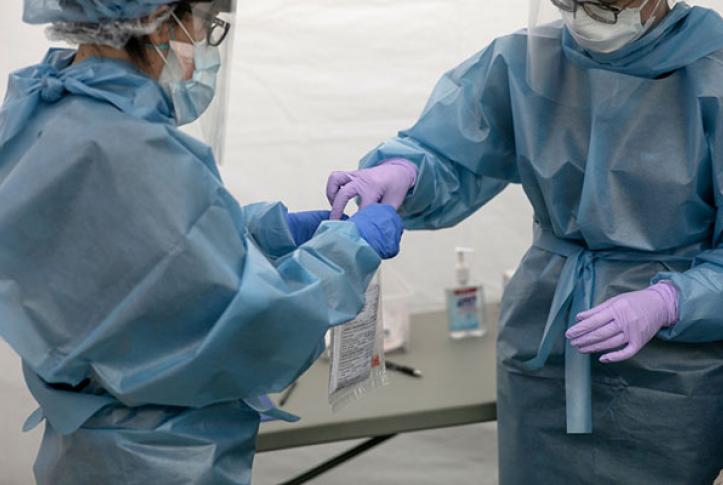The Trump administration has largely delegated COVID-19 testing to states while denying them additional funding to implement a comprehensive testing strategy. This has left states — in the midst of their own budget crises — to decide how to target, administer, and finance asymptomatic COVID-19 testing for essential workers in high-risk industries that require close human contact. These include long-term care, childcare, food retail, farming, and food production. These jobs tend to be low-paid and workers often lack insurance. Furthermore, many are members of racial and ethnic minorities — the very people who have borne the greatest health burdens during the pandemic.
Some states have already recommended or required testing of some asymptomatic workers in high-risk workplaces. Left to go it alone, states approaches will vary significantly. This blog post identifies considerations and challenges for state policymakers.
Identifying High-Risk Workplaces
There is currently no official list of “high-risk” workplaces. The Occupational Health and Safety Administration identifies some categories — such as certain health care workers — as highest-risk, but notes that any worker in a job requiring frequent or close contact with the public (e.g., high-volume retail settings) will be at elevated risk. Yet the administration has targeted only workers at long-term-care facilities for routine testing, leaving states to come up with their own lists, which often depend on factors like ongoing interaction with state-defined vulnerable populations or being located in an area with high rates of community transmission.
Type, Frequency, and Cost of Asymptomatic Testing
In addition to identifying high-risk workplaces, states must develop workplace testing standards, including for asymptomatic testing — that is, testing for people without symptoms or suspected exposure to COVID-19 — which is critical to controlling community spread. The Centers for Disease Control and Prevention (CDC) recommends initial testing of all individuals in high-risk settings followed by periodic (e.g., weekly) testing. But state requirements may vary and could include enhanced testing of workers who rely on public transport or live in communal settings, for example.
States also must consider which tests to require. The CDC recommends viral testing to diagnose an acute infection, but the tests vary in processing time, accuracy, and cost. Public health experts are increasingly calling for the use of antigen tests that produce rapid results more cheaply than the molecular tests, albeit with less accuracy.
Financing Options
The question of who pays for COVID-19 tests, especially for asymptomatic workers, has been hotly debated. The federal government could fund the effort; other options are states, employers, and public and private insurers. The jobs that carry some of the greatest exposure risks typically pay low wages, making it unlikely that workers can pay for their own tests.
As part of the $25 billion directed by Congress for COVID-19 testing in legislation passed in April 2020, the CDC recently released $11 billion to states, territories, and tribes to help implement testing plans. This appears inadequate, however, given the scale of testing and follow-up needs. In addition, the administration has determined that federal laws requiring employer health plans to cover COVID-19 tests do not apply to the routine testing of a high-risk workforce. Taking matters into their own hands, 10 states — Arkansas, Louisiana, Maryland, Massachusetts, Michigan, North Carolina, Ohio, Rhode Island, Utah, and Virginia — have formed a consortium to jointly purchase as many as 5 million rapid, coronavirus tests.
Six states — California, Massachusetts, New Jersey, New York, Rhode Island, and West Virginia — require state-regulated insurers to cover the cost of asymptomatic testing for certain workers or individuals, but these laws do not apply to federally regulated self-funded employer plans. State Medicaid programs could cover asymptomatic testing as a preventive service for adults; for young adult workers up to age 21, Medicaid’s Early and Periodic Screening, Diagnostic, and Treatment (EPSDT) benefit presumably would require coverage as part of an “as-needed” health screening. The administration has not yet provided Medicaid guidance regarding either state options or EPSDT requirements.
States could require high-risk employers to meet certain asymptomatic testing standards to reopen. But placing the burden solely on employers not only would raise opposition but could slow job recovery. Regardless of who pays, until we build sufficient capacity for widespread, inexpensive, at-home testing, employers will need ongoing technical assistance and support from public health officials for test selection, development of testing sites and services, monitoring, and contact tracing. Many employers may need public health agencies to perform onsite testing. And even as testing technology improves, employers will likely need considerable assistance with worker follow-up.
Looking Forward
Without a national testing strategy, states will struggle to develop COVID-19 plans, and these will vary in scope and effectiveness, adding yet another hurdle to economic recovery. A comprehensive, uniform policy and the funds to back it up could instead hasten economic recovery and ensure the nation’s health.




